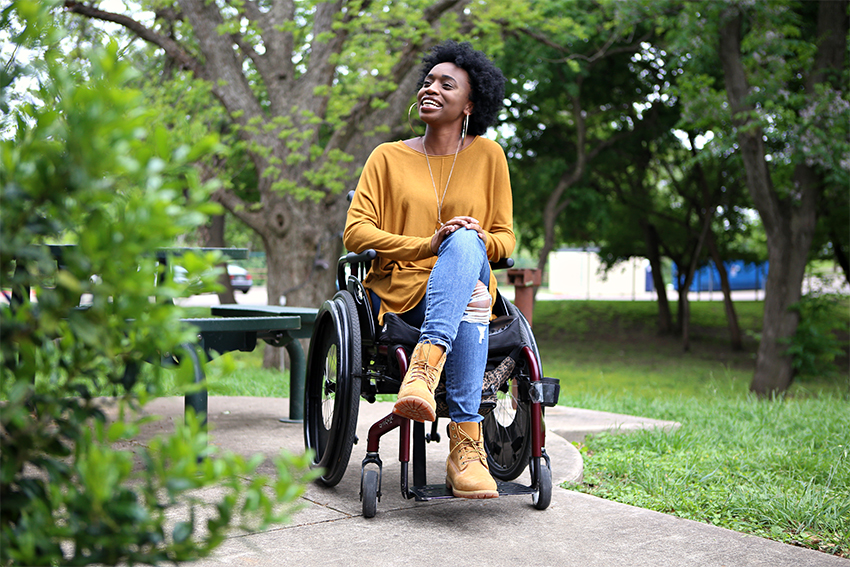As most UT students power walk to class with headphones in their ears and textbooks in hand, finance junior Amie Jean carefully navigates her way through the crowds on Speedway with her sidekick Alfred, her wheelchair.
Coming to UT, Jean thought she was prepared for not seeing many people who looked like her. She knew coming to a predominantly white institution would have its fair share of “tough” experiences, but she said nothing could prepare her for being the only black student in classes with hundreds of students.
“I felt like I needed to join as many black groups as possible,” Jean said. “I felt like maybe I was gasping for air and trying to be as black as I could so I wouldn’t lose myself.”
Then, as she neared the end of her sophomore year, Jean was diagnosed with multiple sclerosis, an autoimmune disease damaging her nerves and making it much more difficult to get around without a wheelchair.
The diagnosis
The Monday after spring break last year, Jean said she left her afternoon class in Burdine Hall when she started to feel extremely weak and could barely walk. After making her way to the East Mall, she ran into her friend Lauren Taylor who took her to the emergency room. Three weeks later, after the hospital ran several tests, Jean was told she had MS.
“I just did my best to be there (for her),” said Taylor, who is now a UT alumna. “I didn’t want Amie to feel like a burden. Nor did I want her to feel like she wasn’t capable of achieving her best work because she couldn’t use her body the way she used to.”
Five months before her diagnosis, Jean said her knee started hurting. At the time, doctors at University Health Services thought it was tendinitis, which Jean thought was weird, but she decided not to question it.
“It always seemed to bounce back,” Jean said about her knee hurting periodically. “I didn’t take it as something seriously.”
Jean said she also started to notice, without realizing what it meant, some of the telltale signs of MS: worsened handwriting, clumsiness, hand tremors and “foot drop,” a symptom where a person is unable to walk heel-to-toe.
When she was diagnosed, Jean said it was a relief. After experiencing strange symptoms for so long, it was nice to finally have an “umbrella” to explain it all, she said.
“I just thought everything was my fault,” Jean said. “One of the only things I was happy about with (the diagnosis) was knowing I’m not crazy.”
Jean left the hospital in a wheelchair, and now uses an electric wheelchair, which she named after Batman’s butler, Alfred, to get around. She said she can, however, usually stand for 10 minutes or walk about 50 yards without getting too fatigued.
Benjamin Greenberg, a neurologist and member of UT Southwestern MS clinic, said people develop MS when their immune system gets “confused” and begins to “wage war” on nerve cells, damaging them and sometimes permanently affecting their function. These cells are unlike most others and cannot be healed easily, if at all.
MS also affects different people in different ways, depending on which nerve cells are attacked, Greenberg said. Worsened vision and difficulty walking are two common symptoms, he said.
Typically, Greenberg said most people do not experience “severe disability” until 10 to 15 years after being diagnosed, if they are left untreated.
“(MS) is extremely treatable, and the treatments we use are meant to prevent the immune system from causing more damage,” Greenberg said.
Dual identities
Jean admitted that after her diagnosis, many people in the black community would ask her when she would be “back on her feet,” but she said it wasn’t easy to admit she did not actually know.
“I felt like because the black community is so disconnected to even the term ‘disability,’ that all of a sudden, the people who knew me best didn’t know me at all,” Jean said.
Jean said that especially in the black community, the stigma of being able to cure yourself and not needing to go to the doctor is what led her to partially step away from the black community at UT.
“At first it really pained me to belong to another minority,” Jean said. “Low-income background, black, disabled, first-generation … I don’t want to merely be a title to these people.”
Jean said she started to feel increasingly isolated. It was hard to try to explain to other people why she suddenly started canceling plans or not coming to meetings because her symptoms occasionally prevented her from going out.
“It’s a lonely diagnosis,” Jean said. “Nobody understands, and nobody can understand. How do I tell you my toes are burning, my joints are burning today?”
Despite it all, Jean said she doesn’t feel defined by having MS and hopes to someday regain enough strength so Alfred will no longer be such an integral part of her life.
“For the most part, it’s not too difficult,” Jean said of life with MS. “It’s just different.”
Longhorn Run
Jean has worked at UT’s visitor center since her freshman year, and her boss, Patrick Olson, tries to get everyone who works there to participate in the Longhorn Run. Last year, prior to her diagnosis with MS, she had been planning on running, but when she left the hospital, she was too weak to compete.
Jean had not planned on participating in the Longhorn Run this year. But Olson, who visited her in the hospital following her diagnosis, said he is “always” thinking about the Longhorn Run and immediately began trying to figure out how she could participate.
Growing up near the Boston Marathon, Olson said he knew about wheelchairs that allow people with mobility issues to participate in runs. He searched for several weeks and found Ainsley’s Angels, a nonprofit providing both wheelchairs and runners to push them for anyone who wants to participate in a run but cannot do so alone.
Olson said he called Ainsley’s Angels representatives from all around the state. In days, Cassey Allen, their Central Texas ambassador, reached out and said they had a chair Jean could use.
For the past month and a half, Jean and Olson met weekly with Allen and another ambassador to train for the race.
“It may look to someone like I’m pushing Amie, but we’re basically running the race together,” Olson said. “I’m the legs, that’s basically it. She’s the energy and the drive and the momentum.”
Allen said she loved helping Olson and Jean for the past few weeks.
“I think (Jean) was caught by surprise by what it would be like to be out there,” Allen said.
On Saturday, Olson and Jean met at 7:30 a.m. to get ready. After getting a personalized announcement from the race’s emcee, Jean, Olson and Dylan Adkins, who was a backup for Olson, took off.
The trio was given an early start, so they would not run over any runners. Throughout the race, Jean served as a navigator and DJ for Olson and Adkins as they wound their way through the 6.2-mile course.
Right around the 45 minute mark, the three crossed the finish line at Speedway and 21st.
“It happened so much faster than any practice day,” Jean said. “It was such a good time, such a good feeling, very thrilling, like, ‘Hey, we did it.’ This is definitely something I want to continue doing.”





















